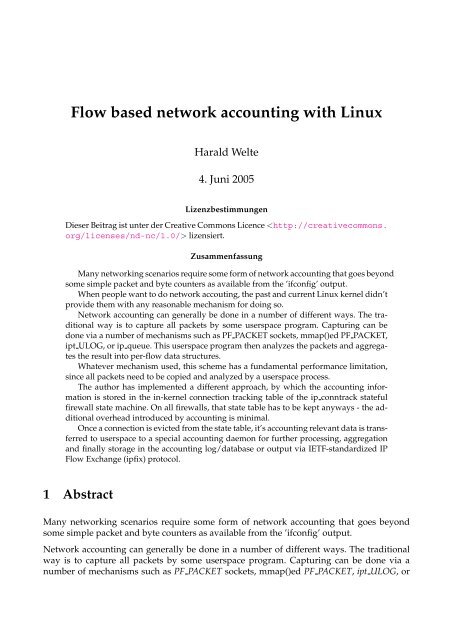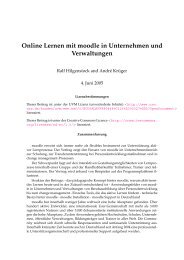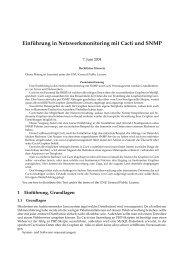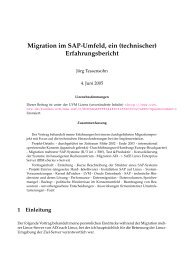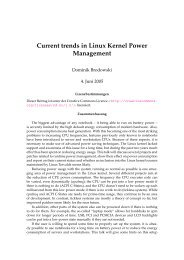Flow based network accounting with Linux
Flow based network accounting with Linux
Flow based network accounting with Linux
Create successful ePaper yourself
Turn your PDF publications into a flip-book with our unique Google optimized e-Paper software.
<strong>Flow</strong> <strong>based</strong> <strong>network</strong> <strong>accounting</strong> <strong>with</strong> <strong>Linux</strong><br />
Harald Welte<br />
4. Juni 2005<br />
Lizenzbestimmungen<br />
Dieser Beitrag ist unter der Creative Commons Licence lizensiert.<br />
Zusammenfassung<br />
Many <strong>network</strong>ing scenarios require some form of <strong>network</strong> <strong>accounting</strong> that goes beyond<br />
some simple packet and byte counters as available from the ’ifconfig’ output.<br />
When people want to do <strong>network</strong> accouting, the past and current <strong>Linux</strong> kernel didn’t<br />
provide them <strong>with</strong> any reasonable mechanism for doing so.<br />
Network <strong>accounting</strong> can generally be done in a number of different ways. The traditional<br />
way is to capture all packets by some userspace program. Capturing can be<br />
done via a number of mechanisms such as PF PACKET sockets, mmap()ed PF PACKET,<br />
ipt ULOG, or ip queue. This userspace program then analyzes the packets and aggregates<br />
the result into per-flow data structures.<br />
Whatever mechanism used, this scheme has a fundamental performance limitation,<br />
since all packets need to be copied and analyzed by a userspace process.<br />
The author has implemented a different approach, by which the <strong>accounting</strong> information<br />
is stored in the in-kernel connection tracking table of the ip conntrack stateful<br />
firewall state machine. On all firewalls, that state table has to be kept anyways - the additional<br />
overhead introduced by <strong>accounting</strong> is minimal.<br />
Once a connection is evicted from the state table, it’s <strong>accounting</strong> relevant data is transferred<br />
to userspace to a special <strong>accounting</strong> daemon for further processing, aggregation<br />
and finally storage in the <strong>accounting</strong> log/database or output via IETF-standardized IP<br />
<strong>Flow</strong> Exchange (ipfix) protocol.<br />
1 Abstract<br />
Many <strong>network</strong>ing scenarios require some form of <strong>network</strong> <strong>accounting</strong> that goes beyond<br />
some simple packet and byte counters as available from the ’ifconfig’ output.<br />
Network <strong>accounting</strong> can generally be done in a number of different ways. The traditional<br />
way is to capture all packets by some userspace program. Capturing can be done via a<br />
number of mechanisms such as PF PACKET sockets, mmap()ed PF PACKET, ipt ULOG, or
ip queue. This userspace program then analyzes the packets and aggregates the result into<br />
per-flow data structures.<br />
Whatever mechanism used, this scheme has a fundamental performance limitation, since all<br />
packets need to be copied and analyzed by a userspace process.<br />
The author has implemented a different approach, by which the <strong>accounting</strong> information is<br />
stored in the in-kernel connection tracking table of the ip conntrack stateful firewall state<br />
machine. On all firewalls, that state table has to be kept anyways - the additional overhead<br />
introduced by <strong>accounting</strong> is minimal.<br />
2 Network <strong>accounting</strong><br />
Network <strong>accounting</strong> generally describes the process of counting and potentially summarizing<br />
metadata of <strong>network</strong> traffic. The kind of metadata is largely dependant on the particular<br />
application, but usually includes data such as numbers of packets, numbers of bytes, source<br />
and destination ip address.<br />
There are many reasons for doing <strong>accounting</strong> of <strong>network</strong>ing traffic, among them<br />
• transfer volume or bandwisth <strong>based</strong> billing<br />
• monitoring of <strong>network</strong> utilization, bandwidth distribution and link usage<br />
• research, such as distribution of traffic among protocols, average packet size, ...<br />
3 Existing <strong>accounting</strong> solutions for <strong>Linux</strong><br />
There are a number of existing packages to do <strong>network</strong> <strong>accounting</strong> <strong>with</strong> <strong>Linux</strong>. The following<br />
subsections intend to give a short overview about the most commonly used ones.<br />
3.1 nacctd<br />
nacctd also known as net-acct is probably the oldest known tool for <strong>network</strong> <strong>accounting</strong> under<br />
<strong>Linux</strong> (also works on other Unix-like operating systems). The author of this paper has<br />
used nacctd as an <strong>accounting</strong> tool as early as 1995. It was originally developed by Ulrich<br />
Callmeier, but apparently abandoned later on. The development seems to have continued<br />
in multiple branches, one of them being the netacct-mysql branch, currently at version 0.79rc2.<br />
It’s principle of operation is to use an AF PACKET socket via libpcap in order to capture<br />
copies of all packets on configurable <strong>network</strong> interfaces. It then does TCP/IP header parsing<br />
on each packet. Summary information such as port numbers, ip addresses, number of bytes<br />
are then stored in an internal table for aggregation of successive packets of the same flow.
The table entries are evicted and stored in a human-readable ASCII file. Patches exist for<br />
sending information directly into SQL databases, or saving data in machine-readable data<br />
format.<br />
As a pcap-<strong>based</strong> solution, it suffers from the performance penalty of copying every full<br />
packet to userspace. As a packet-<strong>based</strong> solution, it suffers from the penalty of having to<br />
interpret every single packet.<br />
3.2 ipt LOG <strong>based</strong><br />
The <strong>Linux</strong> packet filtering subsystem iptables offers a way to log policy violations via the<br />
kernel message ring buffer. This mechanism is called ipt LOG (or LOG target). Such messages<br />
are then further processed by klogd and syslogd, which put them into one or multiple system<br />
log files.<br />
As ipt LOG was designed for logging policy violations and not for <strong>accounting</strong>, it’s overhead<br />
is significant. Every packet needs to be interpreted in-kernel, then printed in ASCII format<br />
to the kernel message ring buffer, then copied from klogd to syslogd, and again copied into<br />
a text file. Even worse, most syslog installations are configured to write kernel log messages<br />
synchronously to disk, avoiding the usual write buffering of the block I/O layer and disk<br />
subsystem.<br />
To sum up and anlyze the data, often custom perl scripts are used. Those perl scripts have to<br />
parse the LOG lines, build up a table of flows, add the packet size fields and finally export<br />
the data in the desired format. Due to the inefficient storage format, performance is again<br />
wasted at analyzation time.<br />
3.3 ipt ULOG <strong>based</strong> (ulogd, ulog-acctd)<br />
The iptables ULOG target is a more efficient version of the LOG target described above. Instead<br />
of copying ascii messages via the kernel ring buffer, it can be configured to only copies<br />
the header of each packet, and send those copies in large batches. A special userspace process,<br />
normally ulogd, receives those partial packet copies and does further interpretation.<br />
ulogd is intended for logging of security<br />
violations and thus resembles the functionality of LOG. it creates one logfile entry per<br />
packet. It supports logging in many formats, such as SQL databases or PCAP format.<br />
ulog-acctd is a hybrid<br />
between ulogd and nacctd. It replaces the nacctd libpcap/PF PACKET <strong>based</strong> capture <strong>with</strong> the<br />
more efficient ULOG mechanism.<br />
Compared to ipt LOG, ipt ULOG reduces the amount of copied data and required kernel/userspace<br />
context switches and thus improves performance. However, the whole mechanism is still intended<br />
for logging of security violations. Use for <strong>accounting</strong> is out of its design.
3.4 iptables <strong>based</strong> (ipac-ng)<br />
Every packet filtering rule in the <strong>Linux</strong> packet filter (iptables, or even its predecessor ipchains)<br />
has two counters: number of packets and number of bytes matching this particular rule.<br />
By carefully placing rules <strong>with</strong> no target (fallthrough) rules in the packetfilter ruleset, one<br />
can implement an <strong>accounting</strong> setup, i.e. one rule per customer.<br />
A number of tools exist to parse the iptables command output and summarized the counters.<br />
The most commonly used package is ipac-ng . It supports advanced features such as storing <strong>accounting</strong> data in SQL databases.<br />
The approach works quite efficiently for small installations (i.e. small number of <strong>accounting</strong><br />
rules). Therefore, the <strong>accounting</strong> granularity can only be very low. One counter for each<br />
single port number at any given ip address is certainly not applicable.<br />
3.5 ipt ACCOUNT<br />
ipt ACCOUNT is a specialpurpose<br />
iptables target available from the netfilter project patch-o-matic-ng repository. It<br />
requires kernel patching and is not included in the mainline kernel.<br />
ipt ACCOUNT keeps byte counters per IP address in a given subnet, up to a ’/8’ <strong>network</strong>.<br />
Those counters can be read via a special “iptaccount“ commandline tool.<br />
Being limited to local <strong>network</strong> segments up to ’/8’ size, and only having per-ip granularity<br />
are two limiteations that defeat ipt ACCOUNT as a generich <strong>accounting</strong> mechainism. It’s<br />
highly-optimized, but also special-purpose.<br />
3.6 ntop (including PF RING)<br />
ntop is a <strong>network</strong> traffic probe to show <strong>network</strong><br />
usage. It uses libpcap to capture the packets, and then aggregates flows in userspace. On a<br />
fundamental level it’s therefore similar to what nacctd does.<br />
From the ntop project, there’s also nProbe, a <strong>network</strong> traffic probe that exports flow <strong>based</strong><br />
information in NETFLOW v5/v9 format.<br />
To increase performance of the probe, the author (Luca Deri) has implemented PF RING<br />
, a new zero-copy mmap()ed implementation<br />
for packet capture. There is a libpcap compatibility layer on top, so any pcap-using application<br />
can benefit from PF RING.<br />
PF RING is a major performance improvement, please look at the documentation and the<br />
paper published by Luca Deri.
However, ntop / nProbe / PF RING are all packet-<strong>based</strong> <strong>accounting</strong> solutions. Every packet<br />
needs to be analyzed by some userspace process - even if there is no copying involved. Due<br />
to PF RING optimiziation, it is probably as efficient as this approach can get.<br />
4 New ip conntrack <strong>based</strong> <strong>accounting</strong><br />
The fundamental idea is to (ab)use the connection tracking subsystem of the <strong>Linux</strong> 2.4.x /<br />
2.6.x kernel for <strong>accounting</strong> purposes. There are several reasons why this is a good fit:<br />
• It already keeps per-connection state information. Extending this information to contain<br />
a set of counters is easy.<br />
• Lots of routers/firewalls are already running it, and therefore paying it’s performance<br />
penalty for security reasons. Bumping a couple of counters will introduce very little<br />
additional penalty.<br />
• There was already an (out-of-tree) system to dump connection tracking information to<br />
userspace, called ctnetlink<br />
So given that a particular machine was already running ip conntrack, adding flow <strong>based</strong><br />
acconting to it comes almost for free. I do not advocate the use of ip conntrack merely for<br />
<strong>accounting</strong>, since that would be again a waste of performance.<br />
4.1 ip conntrack acct<br />
ip conntrack acct is how the in-kernel ip conntrack counters are called. There is a set of four<br />
counters: numbers of packets and bytes for original and reply direction of a given connection.<br />
If you configure a recent (>= 2.6.9) kernel, it will prompt you for CONFIG IP NF CT ACCT.<br />
By enabling this configuration option, the per-connection counters will be added, and the<br />
<strong>accounting</strong> code will be compiled in.<br />
However, there is still no efficient means of reading out those counters. They can be accessed<br />
via “cat /proc/net/ip conntrack“, but that’s not a real solution. The kernel iterates over all<br />
connections and ASCII-formats the data. Also, it is a polling-<strong>based</strong> mechanism. If the polling<br />
interval is too short, connections might get evicted from the state table before their final<br />
counters are being read. If the interval is too small, performance will suffer.<br />
To counter this problem, a combination of conntrack notifiers and ctnetlink is being used.<br />
4.2 conntrack notifiers<br />
Conntrack notifiers use the core kernel notifier infrastructure (struct notifier block) to notify<br />
other parts of the kernel about connection tracking events. Such events include creation,
deletion and modification of connection tracking entries.<br />
The conntrack notifiers can help us overcome the polling architecture. If we’d only listen to<br />
“conntrack delete“ events, we would always get the byte and packet counters at the end of<br />
a connection.<br />
However, the events are in-kernel events and therefore not directly suitable for an <strong>accounting</strong><br />
application to be run in userspace.<br />
4.3 ctnetlink<br />
ctnetlink (short form for conntrack netlink) is a mechanism for passing connection tracking<br />
state information between kernel and userspace, originally developed by Jay Schulist and<br />
Harald Welte. As the name implies, it uses <strong>Linux</strong> AF NETLINK sockets as its underlying<br />
communication facility.<br />
The focus of ctnetlink is to selectively read or dump entries from the connection tracking<br />
table to userspace. It also allows userspace processes to delete and create conntrack entries<br />
as well as “conntrack expectations“.<br />
The initial nature of ctnetlink is therefore again polling-<strong>based</strong>. An userspace process sends a<br />
request for certain information, the kernel responds <strong>with</strong> the requested information.<br />
By combining conntrack notifiers <strong>with</strong> ctnetlink, it is possible to register a notifier handler that<br />
in turn sends ctnetlink event messages down the AF NETLINK socket.<br />
A userspace process can now listen for such DELETE event messages at the socket, and put<br />
the counters into it’s <strong>accounting</strong> storage.<br />
There are still some shortcomings inherent to that DELETE event scheme: We only know the<br />
amount of traffic after the connection is over. If a connection lasts for a long time (let’s say<br />
days, weeks), then it is impossible to use this form of <strong>accounting</strong> for any kind of quota-<strong>based</strong><br />
billing, where the user would be informed (or disconnected, traffic shaped, whatever) when<br />
he exceeds his quota. Also, the conntrack entry does not contain information about when<br />
the connection started - only the timestamp of the end-of-connection is known.<br />
To overcome limitation number one, the <strong>accounting</strong> process can use a combined event and<br />
polling scheme. The granularity of <strong>accounting</strong> can therefore be configured by the polling<br />
interval, and a compromise between performance and accuracy can be made.<br />
To overcome the second limitation, the <strong>accounting</strong> process can also listen for NEW event<br />
messages. By correlating the NEW and DELETE messages of a connection, <strong>accounting</strong> datasets<br />
containign start and end of connection can be built.<br />
4.4 ulogd2<br />
As described earlier in this paper, ulogd is a userspace packet filter logging daemon that is<br />
already used for packet-<strong>based</strong> <strong>accounting</strong>, even if it isn’t the best fit.
ulogd2, also developed by the author of this paper, takes logging beyond per-packet <strong>based</strong><br />
information, but also includes support for per-connection or per-flow <strong>based</strong> data.<br />
Instead of supporting only ipt ULOG input, a number of interpreter and output plugins,<br />
ulogd2 supports a concept called plugin stacks. Multiple stacks can exist <strong>with</strong>in one deamon.<br />
Any such stack consists out of plugins. A plugin can be a source, sink or filter.<br />
Sources acquire per-packet or per-connection data from ipt ULOG or ip contnrack acct.<br />
Filters allow the user to filter or aggregate information. Filtering is requird, since there is no<br />
way to filter the ctnetlink event messages <strong>with</strong>in the kernel. Either the functionality is enabled<br />
or not. Multiple connections can be aggregated to a larger, encompassing flow. Packets<br />
could be aggregated to flows (like nacctd), and flows can be aggregated to even larger flows.<br />
Sink plugins store the resulting data to some form of non-volatile storage, such as SQL databases,<br />
binary or ascii files. Another sink is a NETFLOW or IPFIX sink, exporting information<br />
in industy-standard format for flow <strong>based</strong> <strong>accounting</strong>.<br />
4.5 Status of implementation<br />
ip conntrack acct is already in the kernel since 2.6.9.<br />
ctnetlink and the conntrack event notifiers are considered stable and will be submitted for<br />
mainline inclusion soon. Both are available from the patch-o-matic-ng repository of the netfilter<br />
project.<br />
At the time of writing of this paper, ulogd2 development was not yet finished. However, the<br />
ctnetlink event messages can already be dumped by the use of the “conntrack“ userspace<br />
program, available from the netfilter project.<br />
The “conntrack“ prorgram can listen to the netlink event socket and dump the information<br />
in human-readable form (one ASCII line per ctnetlink message) to stdout. Custom <strong>accounting</strong><br />
solutions can read this information from stdin, parse and process it according to their<br />
needs.<br />
5 Summary<br />
Despite the large number of available <strong>accounting</strong> tools, the author is confident that inventing<br />
yet another one is worthwhile.<br />
Many existing implementations suffer from performance issues by design. Most of them are<br />
very special-purpose. nProbe/ntop together <strong>with</strong> PF RING are probably the most universal<br />
and efficient solution for any <strong>accounting</strong> problem.<br />
Still, the new ip conntrack acct, ctnetlink <strong>based</strong> mechanism described in this paper has a clear<br />
performance advantage if you want to do acconting on your <strong>Linux</strong>-<strong>based</strong> stateful packet-
filter - which is a common case. The firewall is suposed to be at the edge of your <strong>network</strong>,<br />
exactly where you usually do <strong>accounting</strong> of ingress and/or egress traffic.


